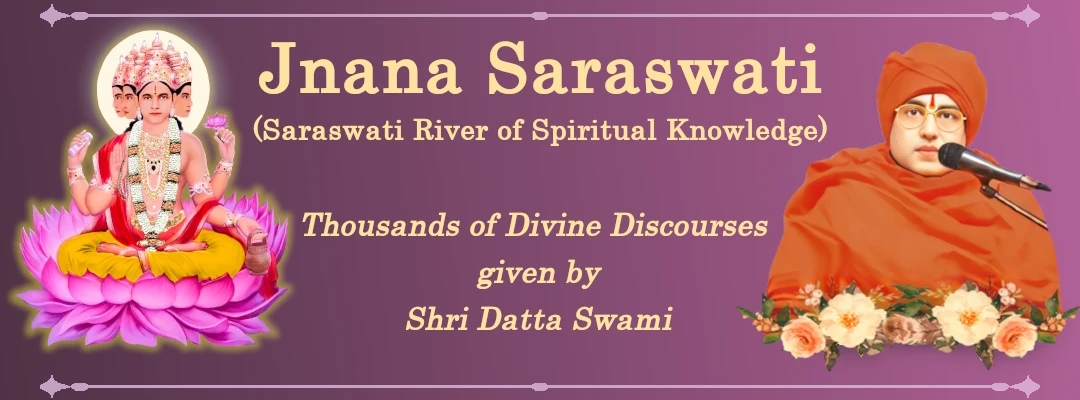
Posted on 24 Apr 2023. Share
[Dr. Nikhil asked: Padanamaskarams Swamiji, Based on last night's (15/04/2023) discussion in the satsang, regarding the Puruṣa Sūktam, I seek the answer to the following question from You. Your servant, Nikhil.
The Māṇḍūkya Upaniṣat describes the mediated God (God Datta) to be made of four parts (So’yamātmā catuṣpāt). These four parts are described to be the four states of waking, dream, deep sleep, and the fourth unimaginable state (Parabrahman). In the Puruṣa Sūktam, the mediated God (God Datta) is said to have four parts in a different sense, as described in the following verses:
etāvānasya mahimāto jyāyā~śca pūruṣaḥ ।
pādo'sya viśvā bhūtāni tripādasyāmṛtaṃ divi ॥3॥
tripādūrdhva udaitpūruṣaḥ pādo'syehābhavatpunaḥ ।
tato viṣvaṅ vyakrāmatsāśanānaśane abhi ॥4॥
Could You kindly explain the meaning of the same.]
Swami replied:- The unimaginable God, called Parabrahman created the energetic body and energetic soul (soul is also a modification of inert energy only like matter) and this first energetic medium (body and soul) was charged by the unimaginable God. The resultant first energetic incarnation is called God Datta, who is also called as Hiranyagarbha, Narayana, Ishvara and Father of heaven. This first energetic incarnation of God (Parabrahman) is said to be in four parts and three parts are divine while the fourth part is mortal medium (Pādo'syehābhavat punaḥ, tripādasyāmṛtaṃ divi). Of course, in the case of God Datta, the fourth part is also immortal, but, it is distinguished from Parabrahman having no birth and death whereas the first energetic medium has birth but no death. When God Datta becomes incarnations, the media have both birth and death. In this way, Parabrahman is distinguished from any media (energetic or human including the first energetic medium).
Hence, any incarnation has three immortal parts of Parabrahman and one part that is created by Parabrahman. What are the three divine parts of Parabrahman? The three divine parts of Parabrahman are:- The first divine part creating the creation (Hiranyagarbha), the second divine part maintaining and ruling the creation (Narayana) and the third divine part dissolving the creation (Iishvara). These divine parts together as one entity is God Datta and He is called as Father of heaven by other foreign religions. The Veda says that the divine portion (the three divine parts) called as Anashanam (not taking any food) whereas the mortal portion, the fourth part of creation is called as Saashanam (taking food). This is told elsewhere in the Veda (Tayorekaḥ pippalam…). The word ‘Abhi’ means that which is before your eyes or the human incarnation of God. This human incarnation of God is also beyond the creation because the same unimaginable nature of Parabrahman exists with this human incarnation due to the presence of Parabrahman inside the medium (Tato viśvaṅ vyakrāmat). Even though the external medium is in this world, by nature, this medium merged with the unimaginable God became the unimaginable God Himself (Tripādūrdhva udait puruṣaḥ). This meaning is also told in the Veda elsewhere that this mediated God is God by Himself and also the medium (Sat ca tyat ca abhavat). By seeing the creation, which is wonderful and infinite for the souls, we can understand that this human incarnation, which is Parabrahman by Himself, is the creator of this infinite creation and is far far greater than this creation (Etāvānasya mahimā, Ato jyāyā~śca pūruṣaḥ). In the Manduukya Upanishad, the same above explained incarnation of Parabrahman is explained in the context of the four states called awaken, dream, deep sleep and the fourth unimaginable state of Parabrahman. The above explained four states in the Purusha Suktam etc., are related to the configuration of the incarnation, whereas the four states explained in the Maanduukya Upanishad are the states existing externally and hence, there is no need of any correlation between the two sets of four states.
★ ★ ★ ★ ★
Also Read
Questions Related To The Mandukya Upanishad - Part-1
Posted on: 11/02/2017Questions Related To The Mandukya Upanishad - Part-2
Posted on: 11/02/2017Mediated Unimaginable God Better Than Non-mediated Unimaginable God
Posted on: 14/08/2017Why Are The Waker And The Dreamer Said To Be Made Of Seven Parts In The Mandukya Upanishad?
Posted on: 20/03/2023
Related Articles
Is There Any Significant Difference Between Parabrahman And God Datta?
Posted on: 08/08/2022Is It True That He Who Knows Parabrahman Becomes Parabrahman?
Posted on: 02/08/2024How Can A Human Incarnation In The Human Form Be Considered As God?
Posted on: 09/04/2023